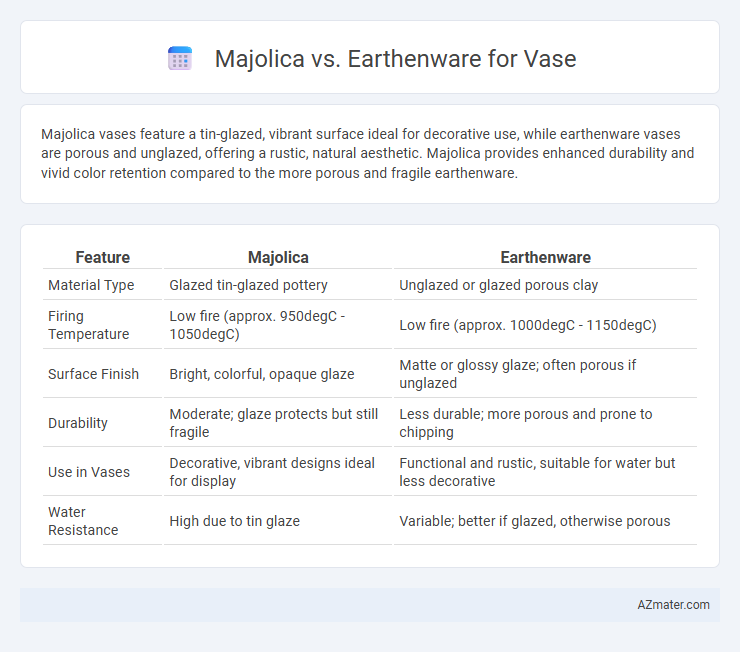Majolica vases feature a tin-glazed, vibrant surface ideal for decorative use, while earthenware vases are porous and unglazed, offering a rustic, natural aesthetic. Majolica provides enhanced durability and vivid color retention compared to the more porous and fragile earthenware.
Table of Comparison
| Feature | Majolica | Earthenware |
|---|---|---|
| Material Type | Glazed tin-glazed pottery | Unglazed or glazed porous clay |
| Firing Temperature | Low fire (approx. 950degC - 1050degC) | Low fire (approx. 1000degC - 1150degC) |
| Surface Finish | Bright, colorful, opaque glaze | Matte or glossy glaze; often porous if unglazed |
| Durability | Moderate; glaze protects but still fragile | Less durable; more porous and prone to chipping |
| Use in Vases | Decorative, vibrant designs ideal for display | Functional and rustic, suitable for water but less decorative |
| Water Resistance | High due to tin glaze | Variable; better if glazed, otherwise porous |
Introduction to Majolica and Earthenware
Majolica is a type of earthenware characterized by its tin-glazed surface that creates a vibrant, glossy finish ideal for decorative vases. Earthenware, a broader category of ceramic pottery, is made from porous clay fired at lower temperatures, offering durability and a rustic aesthetic. Majolica's unique glazing technique distinguishes it from standard earthenware by enhancing both color intensity and surface texture.
Historical Origins of Majolica and Earthenware
Majolica pottery originated in the 15th-century Italian Renaissance, characterized by its tin-glazed earthenware decorated with vibrant colors and intricate designs. Earthenware, dating back to prehistoric times, is one of the oldest forms of pottery, made from porous clay fired at low temperatures. The historical distinction lies in Majolica's decorative glazing technique versus earthenware's more utilitarian, unglazed or simply glazed surfaces.
Material Composition: What Sets Them Apart
Majolica vases are characterized by a tin-glazed earthenware composition, creating a bright, opaque white surface ideal for vibrant, detailed painted designs. Earthenware, made from porous clay fired at lower temperatures, lacks the distinctive tin glaze, resulting in a more porous and less durable finish. The key material difference lies in majolica's glaze, which enhances water resistance and decorative appeal, while standard earthenware offers a more rustic, natural texture.
Visual Characteristics: Color, Glaze, and Texture
Majolica vases feature vibrant, multi-colored glazes with a glossy, smooth finish that highlights intricate decorative patterns, creating a bright and ornamental appearance. Earthenware vases tend to have a more rustic, matte texture with earthy, muted tones and often showcase natural imperfections that add to their handmade charm. The thick glaze on Majolica enhances color saturation and visual depth, while earthenware's porous surface offers a tactile, organic feel.
Durability and Functional Differences
Majolica vases feature a tin-glazed surface that provides a durable, water-resistant coating ideal for holding fresh flowers and water without degradation over time. Earthenware vases, made from porous clay fired at lower temperatures, require a glaze to hold water and tend to be more fragile and prone to chipping or cracking. In terms of functionality, Majolica offers greater longevity and rust resistance, while earthenware is often preferred for its rustic aesthetic but demands careful handling and sealing to maintain usability.
Crafting Techniques and Production Process
Majolica vases are crafted using a tin-glazed earthenware technique, where a white opaque glaze is applied to a porous clay body, followed by painted designs and a final firing that bonds the vibrant colors to the surface. Earthenware vases, on the other hand, undergo a simpler production process involving a single firing of unglazed or glazed clay at lower temperatures, resulting in a more porous and less durable finish. The tin glaze in majolica not only enhances aesthetic appeal with glossy, colorful decorations but also provides a protective layer that distinguishes it from the more rustic, matte texture of traditional earthenware.
Cost Comparison: Affordability and Value
Majolica vases typically cost more than earthenware due to their intricate glazing and decorative techniques, reflecting higher craftsmanship value. Earthenware offers greater affordability, making it a practical choice for budget-conscious buyers who prioritize cost over fine detail. Despite the price difference, Majolica vases often hold better long-term value as collectible art pieces.
Suitability for Vase Making: Pros and Cons
Majolica ceramics, known for their vibrant tin-glazed surface and intricate painted designs, offer excellent aesthetic appeal and durability for vases but tend to be more fragile due to their glazed finish, making them suitable primarily for decorative rather than functional use. Earthenware, characterized by its porous and thicker body fired at lower temperatures, provides greater sturdiness and easier shaping, making it ideal for both functional and decorative vases, though it requires sealing to prevent water absorption and damage. Choosing between Majolica and Earthenware depends on prioritizing vibrant color and detail versus durability and water resistance in vase production.
Collectibility and Artistic Value
Majolica vases, known for their vibrant tin-glazed surfaces and intricate hand-painted designs, often hold higher collectibility and artistic value compared to earthenware due to their historical significance and decorative detail. Earthenware, typically more porous and less refined, is prized for its rustic charm and cultural authenticity but generally appeals to collectors seeking simpler, utilitarian pieces. The unique glazing techniques and color palettes of Majolica contribute to its status as a sought-after collectible, reflecting artistic craftsmanship from regions like Italy and Mexico.
How to Choose Between Majolica and Earthenware for Vases
Choosing between Majolica and Earthenware vases depends on durability, finish, and decorative style. Majolica vases feature vibrant, glossy glazes with intricate painted designs, making them ideal for ornamental use, while Earthenware vases offer a more rustic, matte finish suited for natural or minimalist decor. Consider the vase's intended use--Majolica is often less porous and better for holding water, whereas Earthenware may require sealing to prevent absorption and longer-term durability.

Infographic: Majolica vs Earthenware for Vase
 azmater.com
azmater.com